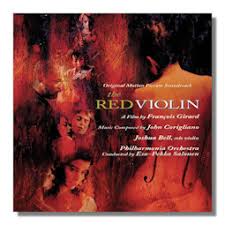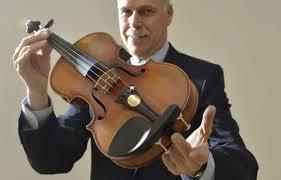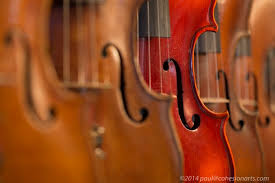The lack of performing arts events during this time of shuttered concert halls has brought its own silver lining: the opportunity, indeed, the hunger, to revisit films that incorporate the classical music world and/or its instruments. And you know, reader, which instrument to which I am most partial, right? Step in François Girard’s 1998 The Red Violin.
I’d forgotten how much I love movies, evocative, romantic ones with global settings (and please, not much violence) that cast a spell on me. The Red Violin, in particular, was so much fun to watch again. I needed the break from reality and I miss classical music events and the performing arts like mad. I love stories you can sink yourself into, and when the main character in a movie is a violin, and is well done, I’m all over it.
The Red Violin can be divided into three sections. First, it’s a picaresque that features the violin as the story’s main character. Which, I know, sounds strange. Humor me as I explain. In the film’s first story-within-a-story, set in 17th century Italy, we encounter Anna, the pregnant wife of esteemed luthier Nicolo Bussotti. Anna asks a servant, the wise but spooky Cesca, to read her future, using tarot cards. (Except, oops, tarot cards weren’t used for divination until the mid-18th century, but this story is so cleverly constructed that I will forgive them this.) The viewer doesn’t realize until well into the film that Cesca was reading not Anna’s, but the violin’s future. This, just as Bussotti (an acclaimed luthier with the artisan skills of Antonio Stradivari) is on the cusp of finishing his greatest violin creation, one, he claims, that will render all his other violins mere junk in comparison. Cesca, reading the cards, declares that she sees a turbulent road ahead, a long life, a long journey, through other lands, through perils of many kind.
Now for the film’s second section.
Four minutes into the film, the scene shifts to a Montreal auction house in present time (well, 1998, when the film was produced). Violin expert Charles Morritz, played by Samuel L. Jackson, has been hired to inspect several centuries-old violins for a high-end Montreal auction firm. One needs an expert for these things because you really can’t tell, at first look, what is a clever forgery or a forgettable 19th century lookalike, and what is the real deal, a seven-figure antique violin made by one of the masters: Stradivari, Guarneri, Guadagnini, Vuillaume, to name but a few. (I blogged about the fascinating world of million-dollar violins HERE.) Anyway, this section begins with the auction taking place, following Morritz’ final evaluations. The camera follows him into the room and then pans the seated audience to pause on other individuals as well (all of whom are related to future story-within-stories). It’s a quick scene, and the focus remains on the auction itself, as one auctioned item, a Stradivarius, is sold, and the auctioneer announces the next item. The much coveted Red Violin.
And like that, we return to 17th century Italy, for the violin’s painful birth story.
I won’t drop a spoiler here, but suffice to say, Cesca’s prophesy that the violin will have a long life unfolds (with frequent, brief returns to her scene, as she turns over a new tarot card and foretells its next fate), as director François Girard sweeps us through the centuries, locale after locale, each with a compelling story, interspersed with the present-day unfoldings in Montreal, and it all works marvelously.
I was delighted to see that YouTube currently has The Red Violin as a free film. Watch it while you can, because it might not remain so easily accessible.
I loved every single vignette and was swept away by the gorgeous cinematography, the period costumes, the historical recreation of post-Renaissance Italy, 18th century Vienna and 19th century England. The story shifts to late 18th century Shanghai, and later, 1966, where Shanghai has become a much harsher place for Western classical music (and instrument) lovers, during Mao’s Cultural Revolution. Here I found some of the best acting and emotion in the whole film. Actors Sylvia Chang and Liu Zi Feng shared an aching exchange where she, as a party official, cannot keep a violin that means the world to her, and he, a cultured teacher of stringed instruments, was just forced to throw his own violin into the bonfire in the main square, along with all the other burning Western artifacts and books that threatened to taint the purity of Mao’s new regime. It was wrenching to watch him hesitate before the bonfire, then finally throw his violin in. And when Chang seeks him out (she also was the one to spare him imprisonment during an earlier public trial) and hands him her violin, the Red Violin, her own terrible pain simmering beneath the surface, he wants to reject it for fear of being arrested a second time. They are stuck, the two of them. They cannot safely have what they love and cherish. Chang insists again that he take the violin and again he rejects the offer. But when she vows to destroy the violin and lifts it behind her like a bat, preparing to bash it against the table, he gasps and grabs it from her. We see the love and longing in his eyes that he was trying not to show. The acting and the pathos were so beautifully and artfully rendered in this scene. Unforgettable.
Curiously, the emotions Samuel L. Jackson portrays, as Charles Morritz, falling under the spell of what he has confirmed to be the long-lost Red Violin, Bissotti’s masterpiece, are so overdone, it annoyed me. He’s a brilliant, charismatic actor, so this surprised me, particularly as his story-within-a-story came right after the aforementioned scene. His character is also, forgive my French, a real asshole, treating people with contempt right and left, so that, by the end, I kinda wanted something bad to befall him, because he seemed to deserve it. Or else, apparently, when you are a Very Important Man on a Very Important Mission, who cares if you treat underlings and hotel staff rudely, even with shouted hostility? Further, his look of longing when hearing the violin played was so overplayed, so obvious, it almost seemed like a different director had taken over and told him to milk it for all it was worth. And it was around this time that Section 3 came into play, the “aha!” mystery of why the Red Violin is red. Again, no spoiler, but suffice to say you’ll guess it, and I don’t buy it, because the compound in question just doesn’t work that way, staying red for centuries, let alone days. But, as I said above, regarding the tarot cards whoopsie, I love this film so much, I am willing to suspend my disbelief and just enjoy the story. And I’m sure plenty of people will adore Samuel L. Jackson’s character, and the suspense his actions brings to the story’s final moments.
Though all this, I can’t believe I haven’t mentioned the music, composed by John Corigliano. An acclaimed American composer, his music has been commissioned, performed, and recorded by many of the most prominent orchestras, soloists, and chamber musicians in the world. His work for The Red Violin won him the 1999 Academy Award for Best Original Score. One can fully appreciate Corigliano’s wide range in a film score like this. There are so many distinct flavors, from Mozart-esque 18th century Vienna, to the raw, sensuous sounds of Gypsy violin, as well as the sweeping, romantic “Anna’s Theme” that carries through the entire movie. Kudos, as well, to the sensational performance by violin soloist Joshua Bell, who performed nearly all the violin solos as a body double (see below) with one charming exception (see above the other below). Hats off, as well, to conductor extraordinaire Esa-Pekka Salonen (the new Music Director for San Francisco Symphony – yay!), leading the Philharmonia Orchestra.
It all comes together into a sublime soundtrack. If you’re a fan of Bell (or if you’re not, this might make you one), this CD is a must-buy. HERE is the Amazon link. I was hoping YouTube had the entire soundtrack under one roof, but apparently not. So I will have to pick a few of my favorites, which is hard, because each story has its own theme music (although “Anna’s Theme” appears through the whole story). The Gypsy music is singular, as well. So. Here you go.
And a fun bit of trivia to share between listens. Remember that “charming exception” I mentioned above, about how Joshua Bell played body double in all the solos (see the original “below” below) except one? Early on in the film, we are introduced to adorable Austrian child-prodigy orphan Kaspar Weiss, who plays like an angel on the Red Violin. Well, it turns out Kaspar was played by the equally prodigious 11-year-old Christoph Koncz (actually he was ten when he started working on the film). Born in 1987 in Konstanz into an Austrian-Hungarian family of musicians, he received his first violin lesson at the age of four and entered the Vienna University of Music only two years later. So, that really IS him playing. Although, like all the other violin-playing scenes, it is reworked in the recording studio and dubbed with Joshua Bell’s performing. So, the soundtrack is still Joshua Bell. But that really is little Kaspar Weiss playing. Amazing to watch. Watch as he is instructed to play a long passage to the ever-increasing speed of the metronome.
And actually, I lied: Bell played all the music on the soundtrack, but there is a scene with a brief solo, played by a wealthy violin collector and virtuoso, at the auction house prior to the actual auction, who later bids on the Red Violin. (We see him in the opening auction scene–remember how I said that opening auction scene shows characters that relate to the various stories? It’s fun to watch the opening scene again, after watching the whole film.) The violinist here is Ireneusz Bogajewicz, a retired member of the Montreal Symphony. He is truly virtuosic. And a great actor too, as it turns out.
And here, finally, is the “see below” you are seeking. This is a bit of fun film trivia, elaborated on in a 1999 Los Angeles Times interview with director François Girard and New York-based music writer Ken Smith. (To read the article in its entirety, click HERE. It’s really good, and interesting!)
Director Francois Girard has a favorite scene in his new film, “The Red Violin.” He calls it the Octopus, though few casual moviegoers could ever figure out why. On screen, a fictional 19th century English violinist named Frederick Pope is seducing his audience with a flamboyant flourish worthy of Paganini.
Just outside range of the camera, however, the scene looked much different. Actor Jason Flemyng had the violin tucked under his chin, but his arms were extended at his sides. Standing to one side and the left was violinist Joshua Bell, his left arm crossing Flemyng’s, his hand curled around the violin’s neck, his fingers moving on the fingerboard. On Flemyng’s right, a British violinist reached across to bow the strings. The players’ arms were tied to Flemyng’s at the elbows, so that when either of them moved, the actor’s body responded.
“The last thing you want in a situation like this, of course, is to focus on the trick,” says Girard with a touch of glee. “You want the audience to connect with the characters, and in this case to connect to a story over great stretches of time and space. A shot like this is not going to make or break a film, but you have to get it right.”
Lastly, the late Roger Ebert, my favorite film critic ever, wrote a lovely review of the film that you can find HERE.



What a great review! I’ll be watching tomorrow afternoon and hope to give more to this comment.
Ooh, so glad you will both be watching it, Donna and Annette. Thanks for commenting here, both of you, and let us all know what you think of the film!
Fascinating, Terez. I look forward to watching this. Its title is especially timely and evocative, given current conditions in California…
WHY DID HE EXCHANGE THE RED VIOLIN FOR THE ENGLISH ONE
It’s the siren call of The Red Violin.